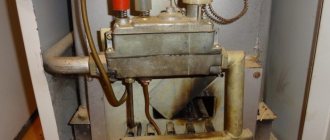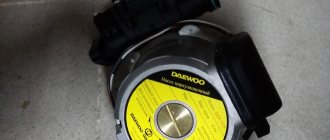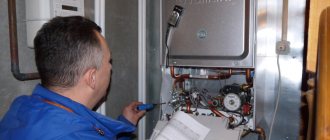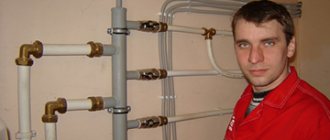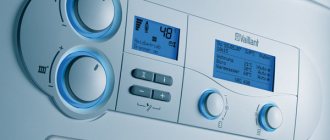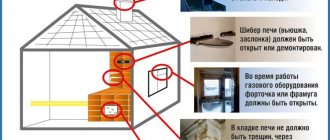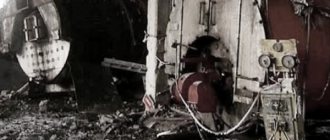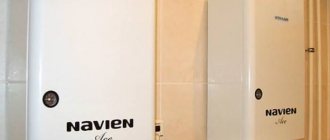Why does reverse thrust appear and how to eliminate it
It is recommended to install the boiler in such a way that the vent and the smoker are on the same side. Failure to comply with the rule in a small building is infrequent, but can do without consequences. In a high-rise building in windy conditions, this can cause pressure differentials. Violation of the norm in this case leads to the appearance of reverse thrust.
Often, a boiler that has not fouled before passes clouds of smoke into the room at the time of kindling after it has completely cooled down. For the normal removal of exhaust gases, it is necessary that the boiler room be warmer than outside. Violation of this rule leads to a natural result - the thrust will not be restored until the heating equipment warms up.
You can restore normal air circulation with the help of a simple technique - light the paper, after placing it closer to the chimney. In this case, the ash pan is left open, and the firebox door is tightly closed. Attempts are repeated until smoke appears from the chimney, indicating that normal thrust has been restored. After such a signal, you can safely start up the heating boiler, without fear that it will begin to smoke.
Solid fuel boilers for home help create quite comfortable heating, and can help the heating system cope with increased demands. They have enough advantages, but from time to time they require maintenance, and always - careful attitude for the purpose of fire safety.
In this article, we will figure out the question that often arises among the owners, why the heating boiler smokes and what to do in such cases. Often, the problem lies in the chimney.
You can find out the price and buy heating equipment and related products from us. Write, call and come to one of the shops in your city. Delivery throughout the territory of the Russian Federation and the CIS countries.
Smoke from the boiler into the room
Equipment cleaning methods
The following methods are used for cleaning:
- Using chemistry. From time to time, special substances are added to the furnace, due to which the accumulated dirt is exfoliated;
- Furnace vacuum cleaner. May help with not very heavy dirt;
- Mechanical. The most time consuming is with the use of brushes and scrapers.
So, if you are looking for possible reasons why a fireplace, stove in a bathhouse or a house is smoking and do not know what to do, use our tips. They will help restore the normal operation of the furnace equipment.
If smoke goes into the room from a gas boiler
A wall-mounted or floor-standing boiler and AOGV can smoke for two main reasons: faulty chimney or poor gas quality.
First of all, you need to inspect the chimney and carry out the following work:
The presence of traction is checked. This can be done either with a special measuring device, or by holding a lighted match. The flame should deviate noticeably towards the boiler. If this does not happen, then the chimney for some reason does not draw smoke out.
View the pipe with a mirror and a flashlight. Remove snow and foreign objects if necessary. If you cannot do this yourself, call a chimney sweep. If you are heating with damp wood, you need to clean the accumulated tar from time to time. Replace the chimney with a suitable type and diameter for this model. For example, the Lemax Premium device requires a chimney with a diameter of 200 mm. Increase the length of the pipe; in your house, its end should end above the ridge of the roof. Insulate it outside with glass wool. View the chimney for cracks
Pay special attention to the connecting seams. Remove right angles when cornering and make the transitions smooth.
In the room where the gas boiler is located, the air vent must be open. This is especially true in the cold season in high-rise buildings, where a layer of cold air can prevent combustion products from escaping.
If you produce heating with a gas boiler and use cylinders, and not a centralized gas pipeline, it is important to purchase high-quality liquefied gas from trusted manufacturers. This allows the Ross Lux model to do this.
What to do if the gas boiler blows out
The first and main reason that the boiler smokes is poor draft in the chimney. This problem is typical for appliances with an open combustion chamber, which require connection to a common chimney shaft. To maintain the flame, the technician takes oxygen from the room, therefore, high-quality ventilation is organized.
The draft in the chimney allows the combustion products to be removed during the operation of the boiler. At the same time, it supplies oxygen to the ignition unit. If there is no draft, the burner may go out, carbon monoxide will start to enter the room.
Why are there problems with draft and the smoke does not go into the chimney? There are several reasons:
- Chimney is blocked. The mine can be clogged with foreign debris and foliage from the street when blown out by the wind. Over time, soot accumulates on its walls, which narrows the chimney passage. Another problem: blocking the top of the pipe. This happens when the hole is blocked with a satellite dish, a lid. In winter, the hole is clogged with snow.
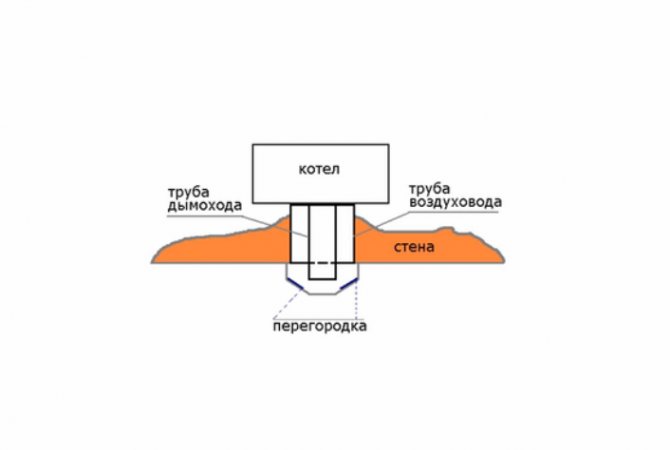
Combustion products are discharged at high temperatures, therefore condensate settles in the mine. In the cold season, it freezes, forming ice.
- The installed type of flue gas vent does not fit your model. The pipe diameter is too small to effectively remove fumes. It is possible that the installation was carried out incorrectly, slopes and heights according to the standards were not taken into account. If the structure is too low, there will be a pressure mismatch. Therefore, natural cravings are not generated. A rarer problem is the installation location. For example, placement on the upwind side. Or there is a tall building nearby, which blocks the air flow.
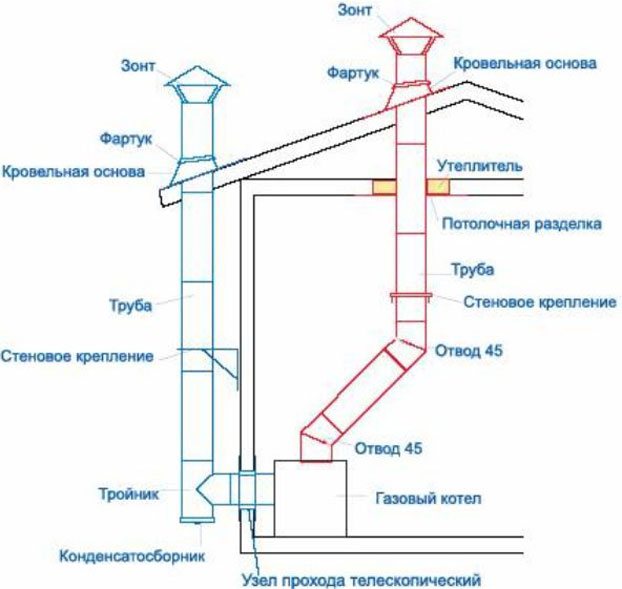

- Leaking connections. Make sure the pipe joints are tightly sealed.
If the floor-standing boiler "Buderus", "Baksi", "Vailant" is located in the boiler room, ventilation for air intake must be on the same side as the chimney. Otherwise, in windy weather, smoke will enter the room.
- Reverse thrust. This is caused by weather conditions, for example, the blowing of the mine by the wind. Pressure drops also lead to problems.
Reverse thrust reasons
Backdraft is one of the possible reasons why the boiler emits smoke when the door is opened. It has already been mentioned above. If the combustible products are not removed through the chimney, but go into the living space, it is worth analyzing the cause of this situation and urgently starting to troubleshoot. As a rule, in this case, the exhaust gas sensor, built-in in units of all modern brands, also reacts.
For all that, a solid fuel boiler emits abundant smoke when the door is opened, contaminates the window on the door. The reason is usually the same. All gases circulate from the high pressure zone to the lower pressure zone. Natural draft appears when the chimney is brought to the optimum height.
You can check if there is a back draft by bringing a lighted match to the chimney. In the case of natural draft, the fire will deviate towards the boiler, but if the reverse draft is from the boiler.
The most common cause of reverse thrust is the weather. A gust of wind penetrates the chimney and prevents harmful waste from escaping. Likewise, when the outdoor temperature drops.Sometimes you just need to wait until the pipe gets warmer, and the natural circulation of combustion products will improve.
It is also possible that the design and type of the chimney was chosen incorrectly. There may be damage. For the unimpeded removal of smoke, the pipe should have as few bends as possible. The diameter and types of the chimney are selected for each boiler based on its type and power parameters.
Smoke reasons
So why does the smoke from the stove go into the house? To find out, it is necessary to conduct a major inspection and find out what caused the smoke. Let's consider the possible reasons below.


Smoke in the room due to improper functioning of the oven
External causes
These factors have nothing to do with the operation of the oven. Sometimes the reason that a stove in a bathhouse or a house smokes is some object that mechanically prevents the outflow of air from the chimney. An overgrown tree, for example, may be such an object. In this case, the problem is easily solved by cutting off unnecessary branches.
Another reason why the stove smokes when firing up can be the ingress of atmospheric precipitation into the chimney, as a result of which the smoke cools too quickly, which leads to the appearance of condensation and the appearance of an air lock. In such cases, a metal umbrella or cap is installed over the pipe.
Poor quality wood may cause black smoke from the chimney.
If the stove has not been used for a long time, the reason why the stove smokes in the house may be an unheated chimney. You can eliminate this cause by using a piece of cloth that needs to be ignited inside the chimney.
Attention! The oven equipment must be cleaned regularly to avoid malfunctioning. Such cleaning should take place annually and be accompanied by a thorough inspection of the oven in order to detect faults in a timely manner.
Reasons related to the design of the furnace
In some cases, the possible reasons why the stove smokes are associated with its design.
- The oven was laid in violation of the established rules. An inappropriate section of the chimney may be the reason why the stove in the bathhouse smokes. In this case, smoke can enter the room. To eliminate this reason, it is better to call the wizard;
- The wind can also be the reason why the stove smokes into the house. To eliminate this cause, you will most likely have to lengthen the chimney. You can also try to change the shape of the visor installed on the head;
- The stove fumes when fired up, when a phenomenon called "draft overturning" occurs. If the stove has not been heated for some time, the air flow can change direction, which happens at any time of the year, and leads to the fact that the stove smokes. It is necessary to increase the temperature inside the chimney. For this purpose, you can open the bur or the uppermost door, which provides access to the inside of the pipe. In an extreme case, the already described method with a lit tissue is used;
- Deficiencies in the laying of the well can also cause the stove to malfunction in a private house. It happens that the stove smokes in the bath when the door is open, while when the door is closed, no deviations are observed. In this case, poor-quality masonry of the entrance to the well can become a source of problems. You will need to re-lay the well. If this is not possible, you will have to erect a wall inside the stove in such a way that its upper edge is slightly higher than the furnace door;
- Another reason why the stove smokes when firing up is often the aging of its parts. This can manifest itself in the narrowing of the chimney due to accumulated soot, the formation of cracks, partial or complete destruction of individual structural elements. If the reason why smoke goes into the house from the stove is due to wear and tear, then it is necessary to thoroughly clean the contaminated parts and repair the destroyed ones;
- Another possible reason why the stove often smokes when the door is opened is the installation of a defective iron door during installation, through which cleaning is carried out. As a result, it does not close tightly, which is the reason why the stove smokes when the door is open.
Important! The danger of resulting smoke should not be underestimated. This can lead to carbon monoxide poisoning.
This equipment is not too difficult to maintain.
However, due to the specifics of its work, it requires some attention during operation. Further in the article, we will consider ways to eliminate the most common problems and the reasons for their occurrence.
What to do if the boiler is "crying"
Condensate starts to flow out of the boiler when the return temperature is too low. This problem requires elimination, since such a malfunction reduces the service life of the boiler. At the same time, soot and soot accumulate inside the equipment. To avoid the occurrence of such a situation in pellet and wood boilers, it is necessary to ensure that the temperature of the coolant in the return line is at least 55 grams.
At the same time, 60-65 grams can be considered the best option. In order to ensure such operating conditions, use Laddomat or three-way mixing valves.
Reasons for overheating of solid fuel boilers and how to fix this problem
A solid fuel boiler can overheat mainly in two cases:
If the premises of the house consume less heat than the boiler itself generates. The features of this equipment are such that precise power control is simply impossible. As a result, the coolant heats up until it begins to boil and the excess steam is discharged through a special valve; Roughly the same situation occurs when the circulation pump stops functioning for any reason. In this case, boiling occurs as a result of the fact that heat removal from the boiler ceases to be carried out.
How can you protect your equipment from overheating? Experts advise using a special storage tank for this purpose, as well as a UPS (uninterruptible power supply).
The latter is necessary, first of all, to ensure the stability of the pump, the former is designed to take excess heat. In order to protect the boiler from overheating, it is worth using the WATTS STS-20 and REGULUS TSV valves.
Other common problems
Very often, owners of solid fuel boilers are also forced to solve the following problems:
Smokes. Poor pipe draft is the reason. Most likely, the air heating of a private house will just need to be cleaned of soot; High fuel consumption. The problem usually lies either in the incorrect connection of the boiler (incorrectly selected power), or in the use of low-quality fuel or poor insulation of the room; Water flows from the chimney. In this case, the latter should be insulated; The burner is clogged in the pellet boiler. To avoid this, use only high quality pellets from certified suppliers.
If the gas boiler smokes
In addition to errors associated with improper installation of equipment, fuel quality plays an important role in the operation of the unit. This issue is especially relevant when using liquefied gas from a cylinder.
After the combustion of clean fuel, a small amount of dry soot remains. Flakes of this substance accumulated in the pipe can be easily removed. It is enough to knock on the chimney from the outside and remove the crumbling soot through the technical window.
After combustion of gas with a large number of impurities on the walls of the chimney, gradually narrowing the gap, greasy soot sticks. It is quite difficult to cleanse this substance.A regular pipe brush may be useless. In such a situation, it would be best to disassemble and clean the smoker separately.
Quite often, a gas boiler smokes due to improper adjustment of the flame intensity. If the user, in violation of all instructions, turned on the burner of a cold boiler at full power, then the appearance of smoke will be a natural result. The problem can be avoided by gradually increasing the combustion temperature after kindling.
What to do when a solid fuel boiler smokes real example
The reasons for the smoke of a solid fuel boiler may be different. Often, when such a situation arises, the owners of the units immediately look for information on the Internet, analyze sites and forums to find real reviews and comments, how to establish the cause of the problems and fix them. Here's one of those examples.
One of the members of the forum complained that having installed a solid fuel boiler of the Dragon TA brand with a classic stainless steel chimney, after two years of unquestioning work, the unit began to smoke. Combustion products began to come out of the chimney inside the boiler room, from all the doors during the firebox.
Kindling was carried out with various types of firewood: spruce, birch, aspen. We used dry, raw and frozen firewood ... The boiler functioned perfectly for two years, and then the situation changed. The owner is sure that the weather conditions have nothing to do with it. The ventilation works great.
The actions of the boiler owner were as follows:
- He took apart the chimney and cleaned it.
- I rewound all connections of the structure with aluminum tape.
- Cleaned out the entire boiler.
- He insulated the chimney with 10 cm ROCKWOOL stone wool.
The solid fuel boiler still smoked inside the boiler room, but the pipe stopped. The owner did not understand what was the matter, why the boiler was smoking.
After much reasoning and communication with people faced with a similar problem, it was still possible to establish the reason, which was as follows.
The owner spent two years heating the boiler with dry chopped aspen and birch logs. In the real season, the cold came already in October, so the dry firewood ran out, and a car of raw birch firewood was bought.
When using dried firewood, dry soot accumulated in the chimney, which could be removed simply by tapping on the vertical part of the chimney with a stick. And everything is clean and tidy. Damp birch logs tightened the walls of the boiler and chimney with tar.
The owner has carried out all the necessary cleaning procedures for the boiler. Removed the tar. And that's it - the problem disappeared.
A solid fuel heating boiler is a good heating medium. But remember that it also requires periodic maintenance and safety rules.
The boiler fumes: causes and remedies
The reasons that the gas boiler smokes
Basically, the reasons why a gas boiler smokes are as follows:
- Insufficient air flow.
- Excess air.
- Poor fuel quality.
- Insufficient gas pressure.
- Burner blockage.
- Insufficient coolant temperature.


Lack of air
Insufficient air flow is usually associated with poor ventilation, a blockage in the chimney, or a change in air flow. If the problem is related to the ventilation of the room where the gas unit is located, it must be cleaned and adjusted.
It happens that the flow of air does not allow ice on the head or a blockage in the pipe to penetrate. Then you have to get rid of these obstacles.
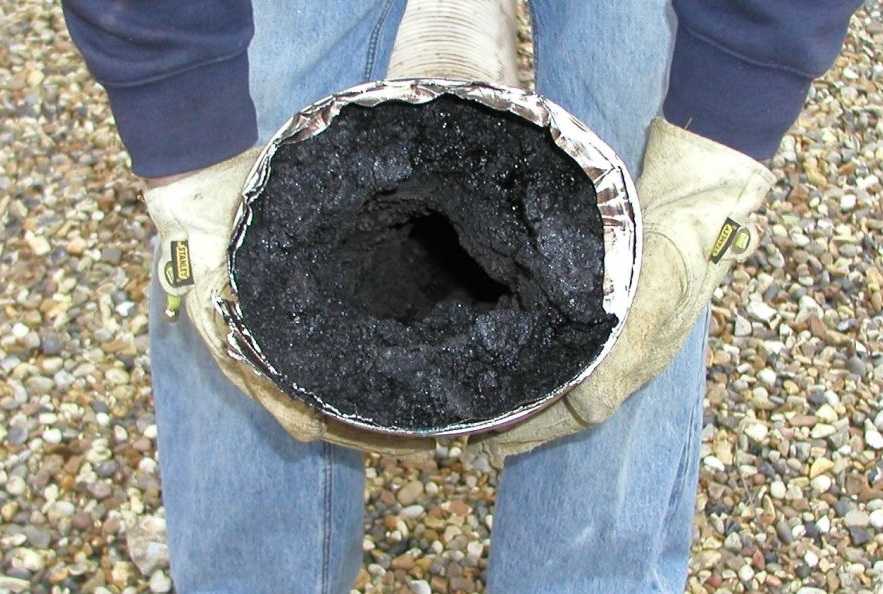

…
Sometimes, in strong winds, pressure drops appear in the pipe, which prevents the flow of air to the burner. In this case, it is worth correcting the design of the gas boiler or installing a deflector on the pipe head.
With a lack of oxygen, the fuel does not burn completely, which is why soot is formed.
Excess air masses
Excessive air flow usually occurs with strong thrust, if there is no adjustment. Excessive thrust occurs due to changes in the weather: low temperatures, changes in air pressure, in strong winds.
With an excess of air masses, the flame is unstable, there is a lack of temperature, as a result of which the gas does not completely burn out and forms soot.
Note! Too little or too much air can be caused by an incorrectly adjusted burner on the unit.
Poor fuel quality
If the fuel contains moisture or impurities, then during combustion they form soot and reduce the performance of gas equipment. In this case, experts recommend installing a filter at the inlet of the gas main.
Find out here why the gas boiler is buzzing - reasons and solutions
…
Why the gas boiler goes out - causes and methods of elimination
Read why the gas boiler works non-stop
Insufficient gas pressure
Also, the reason why a gas boiler can smoke is the low gas pressure. Often this phenomenon occurs in severe frosts, when many consumers are actively starting to consume fuel. Signs of low pressure are:
- short flame with separation;
- decrease in boiler power.
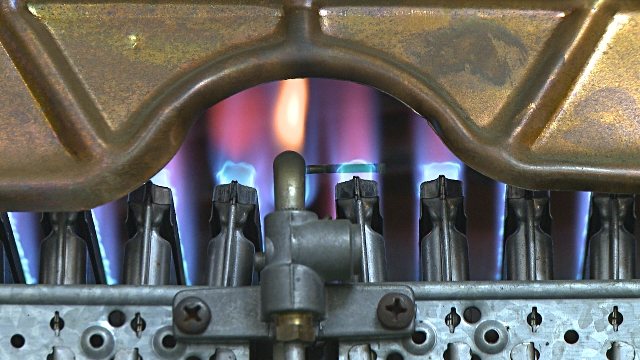

Also, the reasons for insufficient fuel pressure can be:
- blockage of the pipeline;
- malfunctions in the gas meter.
Burner blockage
During operation, especially if the gas is of poor quality, sooner or later the burner becomes clogged with soot and dirt. When fuel is burned in a contaminated burner, not only the gas itself burns out, but also the dirt accumulated on the nozzles, which results in soot.
To prevent this from happening, it is necessary to regularly clean the nozzles or change them.


Insufficient coolant temperature
All boilers have such a characteristic as the maximum temperature of the heating medium. Usually it is 80-85ºC. If the temperature of the liquid is not high enough, the resulting flue gases become too cold, which leads to a weakening of draft and smoking.
What problems arise during the operation of solid fuel boilers
1. When loading fuel into the boiler, smoke escapes into the room - The main reason for the boiler puffing up is insufficient draft in the chimney, lack of supply air for combustion. Check the condition of the chimney. And the main thing is to consult with engineers about the height and diameter of the chimney.
2. Resin adheres to the inner walls of a solid fuel boiler - Raise the operating temperature of the boiler to a level of at least 75 degrees, clean the boiler, install a three-way mixing valve to control the temperature of at least 61 degrees entering the boiler. Use quality fuel!
3. Periodically, water appears under the solid fuel boiler - This is condensation. This process manifests itself when the boiler return temperature is below 51 °; to solve this problem, it is necessary to increase the boiler temperature to 75 ° and install a three-way mixing valve to maintain a stable return temperature of at least 55 °.
4. There is black smoke from the chimney - There is not enough supply air for combustion, or poor quality solid fuel is being used.
5. The fuel in the boiler does not burn - The chimney draft is weak. Cleaning is required for the chimney or you need to increase the cross-section-height of the chimney of a solid fuel boiler. Study the boiler manual, adjust the regulators.
6. The boiler often clogs up - Increase the boiler temperature, use a better quality fuel. Not enough air supply or draft in the chimney.
7. Firewood burns normally, but coal does not burn - The chimney size does not match the boiler output.
8. When the water is heated in the heating system, the pressure rises significantly - The expansion (compensation) tank is damaged or has insufficient volume.
nine.What safety group should be set for a solid fuel boiler - The safety group must comply with the manufacturer's requirements specified in the instructions for the boiler.
10. Solid fuel boiler cannot raise the temperature in the heating system - Raw fuel with insufficient calorific value is used, change the fuel to a more caloric one. For example, briquettes or coal. You need to use more or less dry fuel.
The main problems with solid fuel boilers arise from improper installation and selection of a chimney for the boiler. Also, the operating temperature of the solid fuel boiler plays an important role, as well as the temperature of the heating return line (water that enters the boiler) must be at least 55 °. When buying a boiler, analyze the fuel market, consult with specialists on boiler installation schemes
Also, it is worth paying great attention to the type of boiler and the types of fuels on which a solid fuel boiler can work.
There are four main types of solid fuel boilers - universal boilers, wood-fired boilers, pellet boilers, combined boilers. These boilers are very different in terms of comfort and quality of work on a particular type of solid fuel.
A lot depends on whether you are ready to use solid fuel in heating your premises, as it will take a lot of time and effort when using manual fuel loading, so you should immediately decide whether you need a manual or automatic boiler.
And do not forget to call and consult - this will give answers to many questions, it will also show the level of engineers who offer you quite specific equipment!
Remedies
So, you are faced with a situation when the stove in the house is smoking. To fix the problem, you need to study its nature in more detail:
- If a potbelly stove smokes when the firebox door is opened, the possible reasons are similar to those of a traditional stove. It is necessary to clean it and check the correct installation of the pipe. It is better to melt it with high-quality fuel, without using sawdust or straw;
- The reason why the fireplace often smokes may be poor-quality installation or mistakes made in its design. The height of its pipe should be higher than that of a conventional oven. The inappropriate depth of the firebox can also be the reason why the fireplace smokes in the house. This discrepancy must be corrected by placing a metal plate on the smoke tooth or by filing the edge of the tooth. Also, sometimes the reason why the fireplace began to smoke into the room may be the presence of supply ventilation. You can try to disable it;
- Smokes an iron stove in the bath - dampening its walls, as well as installing an oven under it. Erection of a brick wall between the stove and the cabinet will help;
- The reasons why Buleryan smokes may be associated with the low temperature of the outgoing gas, as a result of which the inner surface of the chimney can be contaminated with soot. Cleaning the pipe will help.
Why does the cauldron smoke
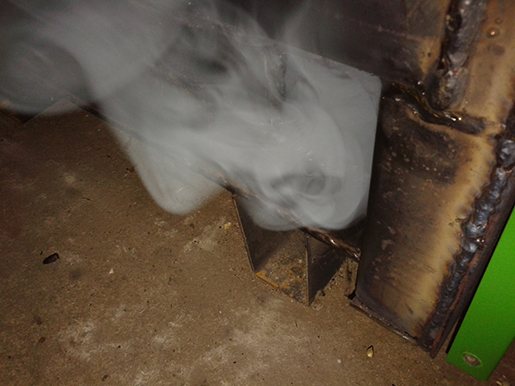

Let's figure out why the boiler is smoking, and what are the main possible causes of this phenomenon. The problem is most likely in the chimney.
Here is a list of suspected faults in this assembly leading to poor traction:
- The chimney is clogged. In winter, snow could get into it or it could freeze. Also, a foreign object could get there from above or soot could gradually accumulate. All of this can be the reason why there is no craving.
- When stoking on wood that is not sufficiently dried, tar accumulates, which greatly narrows the diameter of the pipe and increases the thickness of its walls, preventing it from warming up enough.
- The chimney diameter or type does not match the model's capacity.
- Insufficient height at which the pipe ends. In this case, the pressure difference will not be enough for natural draft to occur.
- Crack or leaky joint in the chimney. Too abrupt changes in direction and pipe bends, where cold air jams form.
Also, the reason may be a sharp change in weather. In the cold season, the thrust is stronger than at high temperatures. In case of strong gusts, the wind blows into the pipe from above.
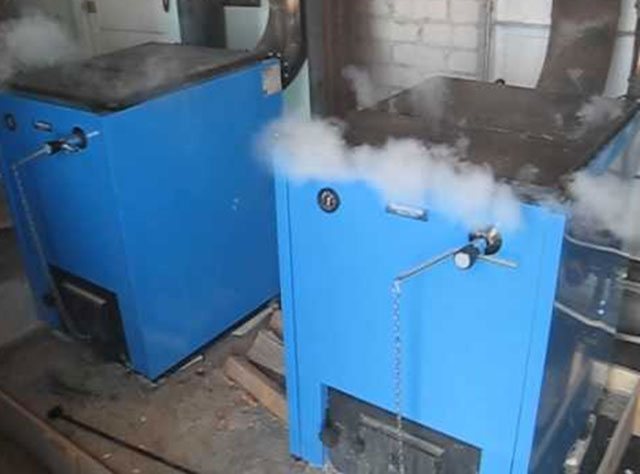

Unsuitable or poor quality fuels also lead to smoke. For example, gas with a large amount of impurities, damp firewood, the ingress of foam or other synthetic materials into a solid fuel boiler
You should also pay attention to the degree of opening of the gate.
Smoke escapes into the room if air does not enter the boiler room during the operation of the boiler. For safety reasons, there must be an air supply from the same side of the house to which the chimney is brought out. Otherwise, strong winds may cause pressure drop and smoke generation inside the building.
A clogged boiler or a too low flow area of the grate can also cause smoke. The device also smokes at the very beginning when firing up, due to the fact that the chimney has not yet heated up.
Preventive measures
It is necessary to clean from the formation of plaque not only the chimney pipe, but also other parts of the stove. Thus, attention should be paid to the following parts of the design:
- Layers of soot are also formed in the ash drawer, the blower and the space under the oven, due to which the potbelly stove can smoke.
Important: If you notice the formation of smoke when you open the door, you should pay attention to the weather outside: if this happens only during the wind, a simple installation of a windproof deflector hood will help.
- It will not be superfluous to check the structure for flaws and cracks that could have formed due to improper assembly of the furnace. Correcting these shortcomings will help to correctly direct the draft of the smoke.
- Sometimes the stove smokes because the door does not fit snugly enough. In this case, either the element is replaced, or the surface of the stove is leveled.
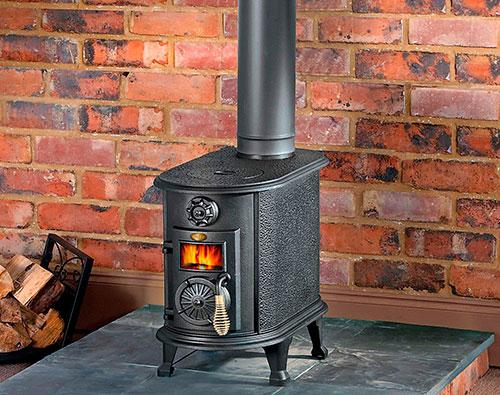

Only high-quality raw materials should be used as fuel and should not be replaced with sawdust and straw.
Troubleshooting solid fuel models
Solid fuel boilers may have the same chimney-related causes of smoke as the gas appliances described above. When firing, it is necessary to use well-dried raw materials. It should be stored in well-adapted places with low humidity levels. Do not use synthetic materials as fuel.
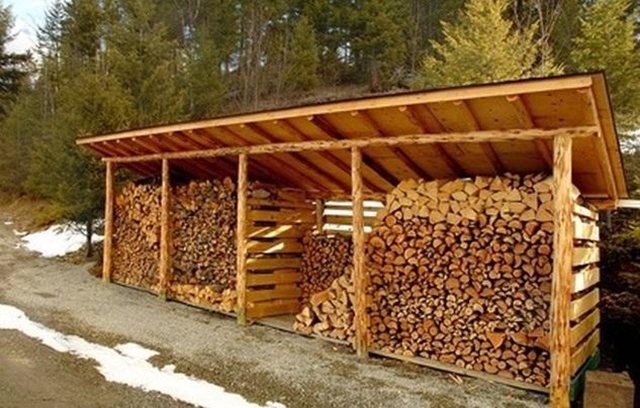

Wood-fired boilers such as Buderus Logano SW, Stropuva S and Zhitomir D should only be fired with dry wood. To be able to use different types of fuel, you need to purchase combined devices such as KST or Smoke. You can experiment with the degree of opening of the gate in hot air models, such. If smoke appears, make the chimney opening larger.
Provide air supply to the boiler room. For safety reasons, the window must be constantly open during the operation of the boiler during the heating season. The solid fuel apparatus must be cleaned regularly. This is especially true if it is coal or diesel, working on mining, since these types of fuels clog the burner especially quickly.
Causes of boiler fuming
Some signs help determine what to look at in the first place when fumes and soot appear in the room. Conditionally, the causes of smoke can be divided into 4 groups:
- Clogged chimney is one of the most common problems. This can be either a foreign object that has entered from the outside, or the result of using low-quality fuel.
- The discrepancy between the chimney power of the boiler or the height of the building is less common and is detected almost immediately, at the very first heating. In a situation where at first everything was fine, and then began to smoke, this reason should not be considered.
- Damage to the chimney is the least likely case. But if the boiler gives off smoke at the beginning of a new heating season, then inspection of the pipe should be one of the first tasks.
- Weather conditions affect natural draft in only two cases: a low chimney height and an incorrect location of the fresh air inflow point.
The smoker should be raised above the roof ridge. The diameter of the pipe is selected in strict accordance with the power of the boiler: a small cross-section simply cannot cope with the removal of smoke from a serious firebox. You should also avoid right angles in places where the pipe changes direction - this makes it difficult for air to circulate, which is not the best reflected in the draft. Visual inspection allows you to identify these shortcomings and eliminate them.

